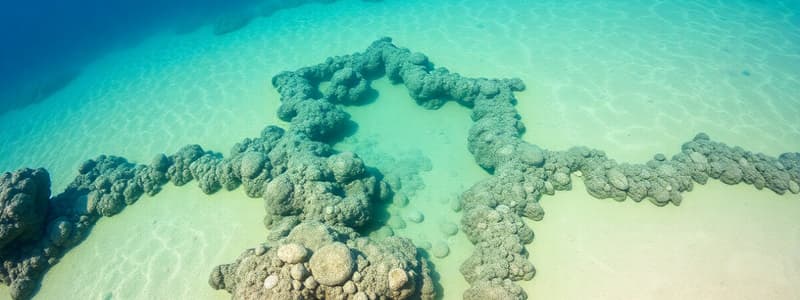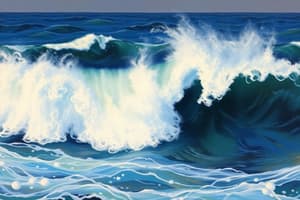Podcast
Questions and Answers
What is the primary reason ice floats on water?
What is the primary reason ice floats on water?
- Ice has a higher temperature than water.
- Ice contains more water molecules than liquid water.
- Water's composition changes when frozen.
- Ice is less dense than liquid water. (correct)
Which property of water allows it to moderate climate effectively?
Which property of water allows it to moderate climate effectively?
- Low heat capacity.
- Substantial density difference.
- High viscosity.
- High heat of vaporization. (correct)
What is a significant factor influencing the distribution of marine life in the ocean?
What is a significant factor influencing the distribution of marine life in the ocean?
- The amount of sunlight reaching the ocean floor.
- Ocean temperature-density relationship. (correct)
- The presence of underwater volcanoes.
- Chemical composition of seawater.
What percentage of Earth's total mass is made up of water?
What percentage of Earth's total mass is made up of water?
How does colder water contribute to the ecosystem at the ocean floor?
How does colder water contribute to the ecosystem at the ocean floor?
What role do comets and meteorites play in Earth's water history?
What role do comets and meteorites play in Earth's water history?
What is true about the bonds in a water molecule?
What is true about the bonds in a water molecule?
Which factor determines the viscosity of water?
Which factor determines the viscosity of water?
What happens to cold water in relation to warm water due to its density?
What happens to cold water in relation to warm water due to its density?
What is the usual salinity level of seawater in Practical Salinity Units (PSU)?
What is the usual salinity level of seawater in Practical Salinity Units (PSU)?
Which phenomenon influences the direction of ocean currents in the Northern Hemisphere?
Which phenomenon influences the direction of ocean currents in the Northern Hemisphere?
During which conditions is surface salinity typically low at high latitudes?
During which conditions is surface salinity typically low at high latitudes?
What effect does the upwelling phenomenon have on nutrient availability in ocean waters?
What effect does the upwelling phenomenon have on nutrient availability in ocean waters?
How does sunlight penetration impact ocean zones?
How does sunlight penetration impact ocean zones?
What is the Ekman spiral effect on water currents?
What is the Ekman spiral effect on water currents?
What primarily drives deep ocean currents?
What primarily drives deep ocean currents?
Which of the following statements about the density of seawater is true?
Which of the following statements about the density of seawater is true?
What is the main driver of wind patterns that influence oceanic circulation?
What is the main driver of wind patterns that influence oceanic circulation?
What primarily causes ocean currents to travel in circular patterns known as gyres?
What primarily causes ocean currents to travel in circular patterns known as gyres?
Which area typically experiences high surface salinity due to high evaporation rates?
Which area typically experiences high surface salinity due to high evaporation rates?
What is the primary reason that cold, salty water sinks in the ocean?
What is the primary reason that cold, salty water sinks in the ocean?
What does the Ekman spiral describe in oceanography?
What does the Ekman spiral describe in oceanography?
Which physical properties are primarily responsible for seawater density?
Which physical properties are primarily responsible for seawater density?
How does high precipitation affect surface salinity at high latitudes?
How does high precipitation affect surface salinity at high latitudes?
What role do Niskin bottles play in oceanography?
What role do Niskin bottles play in oceanography?
What effect does solar energy have on wind patterns at the coast?
What effect does solar energy have on wind patterns at the coast?
What is the primary driver of the process of upwelling in oceans?
What is the primary driver of the process of upwelling in oceans?
Why do deep-sea animals that are red appear black?
Why do deep-sea animals that are red appear black?
What are thermohaline currents driven by?
What are thermohaline currents driven by?
What is the primary composition of seawater in terms of solutes?
What is the primary composition of seawater in terms of solutes?
Which factor contributes to the unique temperature-density relationship of water?
Which factor contributes to the unique temperature-density relationship of water?
What is the main reason for variations in oceanic circulation patterns?
What is the main reason for variations in oceanic circulation patterns?
Flashcards
Radioactive Isotope Dating
Radioactive Isotope Dating
The study of Earth's history based on analyzing radioactive isotopes, revealing our planet's age as 4.6 billion years.
Water's Ancient Presence
Water's Ancient Presence
Water has been present on Earth for almost its entire lifespan, evidenced by fossils of cyanobacteria from the Precambrian era (3.3 billion years ago).
Habitable Zone
Habitable Zone
Earth's unique position in the habitable zone allows for the existence of liquid water oceans, a key factor for life as we know it.
Early Earth Atmosphere
Early Earth Atmosphere
Signup and view all the flashcards
Seawater Density
Seawater Density
Signup and view all the flashcards
Water's Heat Capacity
Water's Heat Capacity
Signup and view all the flashcards
Water's Density Anomaly
Water's Density Anomaly
Signup and view all the flashcards
Water as a Universal Solvent
Water as a Universal Solvent
Signup and view all the flashcards
Salinity
Salinity
Signup and view all the flashcards
Practical Salinity Units (PSU)
Practical Salinity Units (PSU)
Signup and view all the flashcards
Principle of Constant Proportions
Principle of Constant Proportions
Signup and view all the flashcards
Coriolis Effect
Coriolis Effect
Signup and view all the flashcards
Gyres
Gyres
Signup and view all the flashcards
Upwelling
Upwelling
Signup and view all the flashcards
Thermohaline Circulation
Thermohaline Circulation
Signup and view all the flashcards
Photic Zone
Photic Zone
Signup and view all the flashcards
Aphotic Zone
Aphotic Zone
Signup and view all the flashcards
Ekman Spiral
Ekman Spiral
Signup and view all the flashcards
Constant Proportions
Constant Proportions
Signup and view all the flashcards
Oxygen Minimum Zone
Oxygen Minimum Zone
Signup and view all the flashcards
Water Polarity
Water Polarity
Signup and view all the flashcards
High Heat Capacity
High Heat Capacity
Signup and view all the flashcards
Ocean Color
Ocean Color
Signup and view all the flashcards
Ocean Currents
Ocean Currents
Signup and view all the flashcards
Major Ocean Currents
Major Ocean Currents
Signup and view all the flashcards
Oceanography
Oceanography
Signup and view all the flashcards
Study Notes
Earth's Oceans - Formation and Properties
- Earth is approximately 4.6 billion years old, with abundant water throughout its history.
- 3.3 Billion years ago, cyanobacteria fossils were found.
- Earth is unique in our solar system as the only known planet with liquid surface water. Its distance from the sun is ideal for liquid water existence.
- Early Earth's atmosphere formed from volcanic outgassing of water vapor, CO2 and other gases. As the crust cooled, vapor condensed into the oceans. Impacts from comets and meteorites also contributed to the water source.
- Pillow basalt rocks, 4 billion years old, indicate early underwater volcanism.
- Earth's water comprises only 0.023% of its total mass.
Oceanographic Principles
- Understanding oceanography is fundamental to marine biology studies.
- Ocean currents and circulation patterns significantly influence marine life.
- Oceans contain the majority of Earth's biodiversity.
- Life forms in the ocean adapt to specific seawater properties.
Water Properties
- Water (H2O) is a polar molecule due to covalent bonds between hydrogen and oxygen. Hydrogen bonding between water molecules is weak.
- Water is a universal solvent due to its polarity and ability to form different bonds.
- Density of freshwater is 1 g/cm^3. Seawater is denser at 1.02 g/cm^3.
- Viscosity increases with lower temperatures and higher salinity.
- Water has a high heat capacity, moderating global climate.
- Water can dissociate into hydrogen and hydroxide ions.
Temperature and Density
- Water's maximum density occurs as a liquid, which is unusual. This is why ice floats.
- Water molecules cluster closer together at lower temperatures, increasing density. Cold water sinks beneath warmer water.
- Compared to warmer water, colder water holds more oxygen.
- Ice's lower density allows it to float and create habitats in polar regions.
Salinity
-
Seawater is a complex mixture of water and dissolved salts, determined by the total amount of dissolved salts.
-
Salinity, formerly measured in parts per thousand, is now expressed in Practical Salinity Units (PSU).
-
Average salinity is around 35 PSU (representing 35 grams of salt per 1000 mL). Salinity varies geographically: freshwater input at river mouths reduces salinity; high evaporation increases it.
-
Salinity follows the principle of constant proportions, with the ratio of ions remaining consistent.
-
Sources of salt include rock weathering, hydrothermal vents, and dissolved materials from land runoff.
-
High-latitude regions typically have lower salinity due to higher precipitation and runoff, while tropical areas have higher salinity due to high evaporation and low precipitation.
Ocean Currents
- The Coriolis effect deflects moving water to the right in the Northern Hemisphere and to the left in the Southern Hemisphere, influencing ocean currents' paths.
- Gyres are circular current patterns caused by the Coriolis effect.
- Surface currents are primarily driven by wind patterns, which are solar-energy-driven.
- Deep ocean currents are driven by gravity and density differences.
- Thermohaline circulation refers to currents driven by temperature and salinity differences.
- Ekman spiral describes how wind-driven surface currents are deflected at an angle (45°) to the wind direction, with deeper layers being deflected further.
Upwelling
- Upwelling occurs when cold, nutrient-rich water rises to replace warmer water, driven by winds. This upwelling process brings nutrients from deeper water to the surface, benefiting surface life, including the fishing industry.
Light Penetration
- Blue light penetrates the ocean better than other colours, which is why oceans often appear blue.
- Sunlight penetration affects the distribution of life within marine zones.
- Red light doesn't penetrate deeply, making deep-sea animals that are red appear black.
Marine Zones
- Photosynthesis occurs in the photic zone.
- An oxygen minimum exists at about 1000 meters depth.
- Nutrient concentrations increase with depth below the photic zone; however, life is reduced correspondingly.
Studying That Suits You
Use AI to generate personalized quizzes and flashcards to suit your learning preferences.




